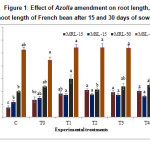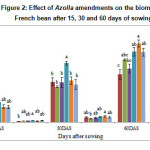Introduction
French bean (Phaseolus vulgaris L.) is an important leguminous, short duration pulse and vegetable crop used as main source of protein in human diet (Anon., 2010). The negative impact of chemical fertilizers on the soil fertility necessitated the need for an alternative supplements to replace the usage of chemical fertilizers (Anon., 1982). Azolla (Azolla pinnata R.Br.) contains high nitrogen content and has been used as a green manure for wetland rice cultivation and also for their capacity to retain large amounts of minerals (Arora and Singh, 2002; Kumar and Rao, 2012). It is one of the supplementary sources of compost used in integration with other bio-fertilizers. As a potential green manure it increases the soil organic matter and nitrogen fixing ability in standing water. Azolla in symbiosis with cyanobacterium (Anabaena azollae) can fix 2-4 kg N ha-1day (Lumpkin and Plucknett, 1982) releasing the nutrients like gibberellins, cytokinins, auxins, abscisic acid, vitamins, antibiotics and amino acids into soil in an easily available form to plants (Bohlool et al., 1992 ; Wagner, 1997). It is extensively used as nitrogen supplement not only for rice cultivation but also for other crops such as Tomato, Wheat, and Taro (Anon., 1982; Kolhe and Mittra, 1990; Marwaha et al., 1992; Milica and Favilli, 1992; Tekle-Haimanot and Doku, 1994). The present study was conducted to know the effects of Azolla on seed germination, vigour index, biomass, and pod yield of French bean.
Materials and Methods
An experiment was conducted in the greenhouse at the Department of Studies in Botany, University of Mysore. Seeds of French bean (variety S-9) obtained from Agro Seed Traders, Mysore. Fresh Azolla biomass was collected from a lake near Hampapura, K. R Nagar, Mysore district and was mass multiplied in the green house conditions. The species of Azolla was identified as per the key characteristics (Carrapico et al., 2000). A total of 120 pots filled with sterilized soil (2kg), sand (1kg) and organic compost (1kg) (2:1:1), incorporated with 10 (T1), 25 (T2), 50 (T3) and 100g (T4) of fresh Azolla biomass. The pots without Azolla biomass served as negative control. Pots with 10 g of Factamfos (20% N and 20% P2O5, 13% of Sulphur) served as positive control. Ten (10) seeds of French bean were sown in each pot and after eight days of sowing, seed germination was determined as per ISTA guidelines. At every 15, 30 and 60 days of sowing, vigour index (VI), biomass and pod yield after 90 days were determined. After 15 days of sowing, seedlings were uprooted, roots were washed in running tap water, shade dried, the mean root length (MRL) and mean shoot length (MSL) were determined and vigour index (VI) was calculated (Anon., 1996). Further the shoots and roots were separated and weighed and biomass was determined. Dry weight was also determined by heating for 16 to18 hours at 105 ± 2 °C in an oven,cooled in a desiccator for 20 min (Anon.,1996). The matured pods were harvested after 90 days of sowing and the yield was calculated.
Data Analysis
The data was statistically analyzed by Analysis of variance (ANOVA) using SPSS Inc. 14.0. Means were separated by Tukey’s HSD (honestly significant difference) test. Significant effects were determined by magnitude of F values (P˂0.001).
 |
Figure 1: Effect of Azolla amendment on root length, shoot length of French bean after 15 and 30 days of sowing. |
 |
Figure 2: Effect of Azolla amendments on the biomass of French bean after 15, 30 and 60 days of sowing. |
Results and Discussion
Azolla species collected from K.R. Nagar was identified as Azolla pinnata R.Br. The plant body appeared pinkish green and turned dark green as it matured. The rhizome was horizontal, deltoid, with minute papilla, up to 2 cm long and 0.2 mm in diameter. Hairy roots were 1-3 up to 3.5 cm long. Leaves were bilobed with the upper lobe imbricate, up to 1.1 mm long with papilla, central portion was chlorophyllous, border with 3-4 cells layers which were hyaline, apex acute; lower lobe similar in size to the upper lobe, but hyaline (Caparrico et al.,2000). The results of seed germination and seedling vigour (VI) are presented in Table-I. Seed germination was ranged from 65-82% and there were significant differences in the seed germination among different Azolla treatments. Maximum seed germination of 81.66% was recorded in the pots incorporated with 25g of Azolla followed by 10g (76.33%), 100g (76.00%) and 50g (72.66%) of Azolla respectively. Similar studies conducted on Pisum sativum seeds soaked in lower concentration of aqueous Azolla extract showed maximum seed germination. A high seed germination rate of 99%, 97%, 97% was recorded in aqueous Azolla extract of 20%, 10% and 5% respectively (Bhindu, 2013). In contrast to seed germination, significant increase in vigour index was observed in all the treatments compared to controls. The seedling vigour of French bean was maximum in T2 (3146.81) followed by T1 (2714.82), T3 (2687.08) and T4 (2677.45) respectively.
Table 1: Effect of Azolla pinnata on seed germination of French bean after 8 days of sowing and seedling vigour after 15days of sowing.
| Treatments | Seed Germination (%) | Seedling vigour (VI) |
| C- Negative control | 64.66 ± 1.76c | 1229.39± 3.79e |
| T0- positive control | 65.66 ± 0.33c | 1880.88±9.01d |
| T 1 (2:1:1+10g Azolla) | 76.33 ± 0.88b | 2714.82±8.05b |
| T 2 (2:1:1+25g Azolla) | 81.66 ± 0.33a | 3146.81± 5.96a |
| T 3 (2:1:1+50g Azolla) | 72.66 ± 0.33b | 2687.08±6.28bc |
| T 4 (2:1:1+ 100g Azolla) | 76.00 ± 0.57b | 2677.45± 2.84c |
| Degree of Freedom | 29 | 29 |
| P Value | ˂0.001 | ˂0.001 |
| F value | 5.52 | 121.04 |
Values are means of five independent replicates; Mean followed by same superscript letter(s) within the column is not significantly different according to Tukey’s HSD.
Table 2: Effect of Azolla on the pod yield of French bean.
| Treatments |
Pod yield(g) |
|
|
Number of days |
||
|
60 |
90 |
|
|
C |
118.0±1.37e |
120.0±0.80e |
|
T0 |
161.6±2.24a |
163.0±1.54a |
|
T1 |
144.4±1.28b |
143.8±1.35b |
|
T2 |
164.6±1.32a |
166.2±1.01a |
|
T3 |
136.0±1.00c |
135.6±0.74c |
|
T4 |
125.0±3.76d |
126.2±1.46d |
|
DF |
29 |
29 |
|
P value |
˂0.05 | |
|
F value |
150.69 |
249.7 |
Values are means of five independent replicates; Mean followed by same superscript letter(s) within the column is not significantly different according to Tukey’s HSD.FW-Fresh weight, DW-Dry weight.
Effect of Azolla on biomass of French bean in terms of fresh weight and dry weight are presented in Figure 2. An increase in French bean biomass was observed in Azolla treatments compared to controls. Maximum biomass was recorded in T2 (25 g) after 15, 30 and 60 days of sowing compared to the controls. Similar results were observed in Pisum sativum (Bhindu, 2013). The effect of Azolla on pod yield after 60 and 90 days of sowing is presented in Table 2. The overall pod yield ranged from 125g-164.6 g and 126.2-166.2g after 60 and 90 days of sowing respectively. Pots containing soil amendment with 25g of Azolla recorded highest yield of 164g after 60 days and 166.2g after 90 days of sowing. Similar results were observed by Marwaha et al., 1992 with the application fresh fronds of Azolla for increased grain yield of Wheat. Incorporation of 200 kg/ha of Azolla biomass also increased the yield of Tomatoes by 21.2% Milica and Favilli, 1992). Effect of Azolla on the yield of Mung bean in terms of increased number of pods and yield per plant after the incorporation of 12 tonnes of Azolla/ha was studied (Ram et al., 1994). The corm yield in Taro (Colocasia esculenta) was increased with the incorporation of 20 tonnes ha-1Azolla into mud and soil application of 0.5 kg m-2 (11) (Tekle-Haimanot, and Doku, 1994). Iron enriched Azolla used as a slow biofetilizer increased the yield of cucumber grown in the hydrophonic system (Plessner et al., 1998). Azolla as a biofertilizer is well known especially in rice fields (Nyalemegbe et al.,1996 ; Sanati et al.,2001; Singh et al., 2011). French bean is an important pulse crop in India with an annual production of 3989 Kg/ha. The application of nitrogen fertilizers positively increases the yield of French bean. However the amendment of Azolla as a supplement certainly reduces the application of nitrogenous fertilizers and increases the soil fertility. The result of the present study showed that the incorporation of 25 g of Azolla/ 4 kg of soil increased the seed germination, seedling vigour, biomass and yield of French bean. Further work need to be conducted to establish the same results and applications methods in field condition..
References
- Anonymous. Current world agriculture production 2010-2011. Food and Agricultural Organization of United Nations (FAO), Rome (2010).
- Anonymous. China and the West: Sharing solutions to agricultural problems. World Farm., 24: 76-78 (1982).
- Arora, A. and Singh P. K. Comparison of biomass productivity and nitrogen fixing potential of Azolla sp. Biomass Bioenerg.,24: 175-178 (2002).
CrossRef - Kumar, S. R. S. and Rao, K.V. B. Biological nitrogen fixation: A Review. Int J Adv Life Sci., 1:1-6 (2012).
- Lumpkin, T.A. and Plucknett, D. L..Azolla as a green manure: Use and management in crop production. 225pp. West view Tropical Agriculture Series No. 5, West view Press, Boulder, CO (1982).
- Bohlool, B.B., Ladaha, J. K., Garrity, D. P. and Gedrge, T. Biological nitrogen fixation for sustainable agriculture; A perspective. Plant soil.,141:1-11(1992).
CrossRef - Wagner, G.M. Azolla: A review on its biology and utilization. Bot Rev., 83(1):1-27(1997).
CrossRef - Kolhe, S. S. and Mittra, B. N..Azolla as an organic source of nitrogen in a rice-wheat cropping system. Trop Agr., 67: 267-269 (1990).
- Marwaha, T. S., Singh, B. V and Goyal, S. K. Effect of incorporation of Azolla on wheat (T. aestivum var. HD – 2329). Acta Bot Indica., 20: 218-220(1992).
- Milica, F. and Favilli, F. Azolla symbiotic system’s: Application as a bio-fertilizer for green garden crops. Symbiosis ,14: 495-500(1992).
- Tekle-Haimanot, A. and Doku, E. V. Comparison of Azolla mexicana and N and P fertilization on paddy Taro (Colocasia esculenta) yield. Trop Agr., 72 (1): 70-72(1994).
- Carrapico, F., Teixeira, G., Diniz, M. A..Azolla as a bio-fertilizer in Africa. A challenge for the future. Rev. Cienc Agrar., 23(3-4): 120-138(2000).
- Anonymous. International rules for seed testing. Seed Sci Technol., 24:155-202(1996).
- Bindhu, K. B. Effect of Azolla extract on growth performance of Pisum sativum. Int J Biol Sci., 2(10): 88-90 (2013).
- Ram, H., Raja, P., Krishna and Naidu, M. V. S. Effect of Azolla on soil properties and yield of Mung bean (Vigna radiata L). J Ind Society Soil Sci., 42 (3): 385-387(1994).
- Plessner, O. E., Chen, Y., Shenker, M. and Tel-Or, E. Iron-enriched Azolla as a slow release bio fertilizer for cucumber plants grown in a hydroponic system. J plant Nutr., 21(11): 2357-2367(1998).
CrossRef - Nyalemegbe, K., Oteng J. W. and Ahiabu R. K. The utilization of Azolla as a source of nitrogen for rice production in Ghana. Ghana J Agric Sci.,29:125-129 (1996).
- Sanati, B. E., Daneshiyan, J., Amiri, E. and Azarpour, E. Study of organic fertilizers displacement in rice sustainable agriculture. Int J Acad Res., 3(2): 786-791(2011).
- Singh, Y. V., Dhar, D. W. and Agarwal, B. Influence of organic nutrient management on basmati rice (Oryza sativa) – Wheat (Triticum aestivum) – green gram (Vigna radiata) cropping system. Indian J Agron., 56 (3): 169-175(2011).
